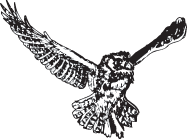

Red-Shouldered Hawk
(Buteo lineatus)
Buteos are the largest group of hawks. They have long, broad and rounded wings and short, broad tails. They are able to soar for hours but they usually hunt by the “sitting and waiting” from a tree or utility pole. They eat a wide variety of prey but mice make up the major part of their diet.
The Red-shouldered Hawk is the diurnal version of the Barred Owl. They also live in wooded groves, along streams and swamps.
Red-shouldered Hawks build nests of sticks, twigs, inner bark strips, dry leaves, moss, lichens and conifer needles close to the trunk of a tree. The nests is lined with fine materials and green leaves which are constantly replenished once incubation starts. The female produces one brood per year of two to four bluish-white eggs. The young hatch asynchronously, that is they differ in size.
Once the young have left the nest, it becomes the family eating platform. Their diet includes rodents, snakes, lizards, insects and occasionally snails. Red-shoulders hunt in forest edges and open woodlands near meadows and fields. A pair of Red-shouldered Hawks may use same territory for many years.




Red-shouldered Hawks migrate south for the winter, but remain within the United States. Most hawks lack the special adaptations needed to survive northern winters. Red-shouldered Hawks were Blue Listed from 1972-86. Today they are declining or have stabilized at low numbers; accurate population numbers are difficult to obtain. Red-shouldered Hawks are known to accumulate organchlorine pesticides and PCBs, but habitat loss is the major threat.